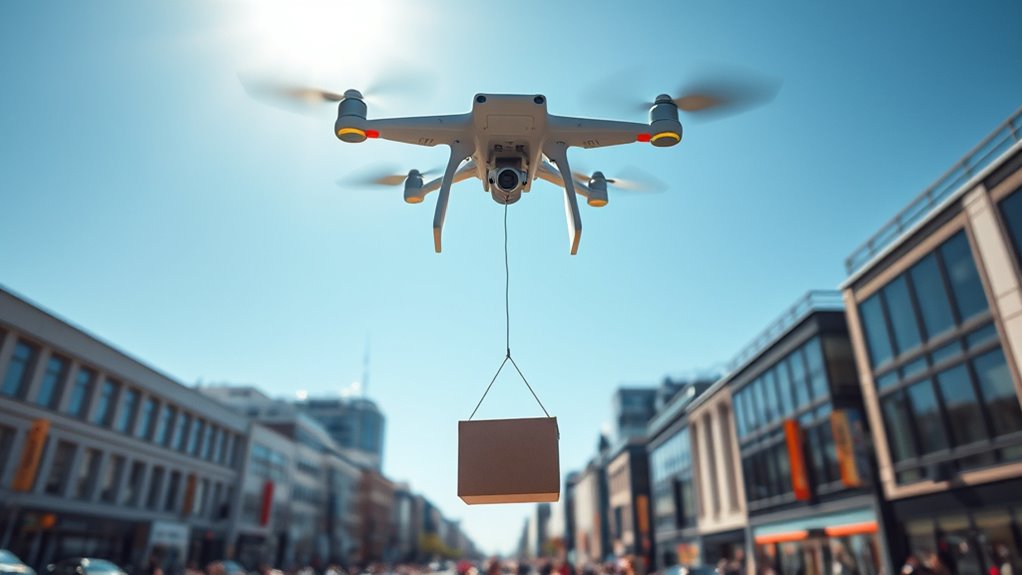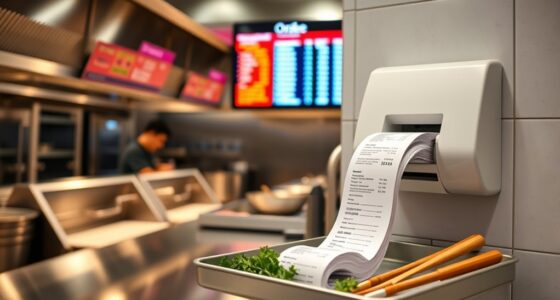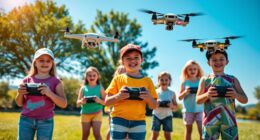Drone delivery pilot programs are testing new ways to speed up delivery times, reduce costs, and improve access in both urban and rural areas. Major companies like Amazon, Wing, and Zipline lead these efforts, working with regulators to guarantee safety and compliance. These pilots face challenges like technical limits and regulations but show promise for transforming logistics. If you’re curious about how these programs evolve, there’s much more to explore.
Key Takeaways
- Pilot programs are initiated by companies like Amazon, Wing, and Zipline to test drone delivery in real-world conditions.
- Regulatory agencies, such as the FAA, oversee approval processes and safety standards for drone operations.
- These programs evaluate logistics, airspace management, obstacle avoidance, and delivery efficiency in targeted areas.
- They often focus on urban, suburban, or remote regions to assess different environmental and infrastructural challenges.
- Outcomes inform regulatory policies, safety protocols, and technological improvements for permanent drone delivery services.
The Evolution of Drone Delivery Technology

The evolution of drone delivery technology has been rapid and transformative, driven by advances in robotics, guidance systems, and battery efficiency. You’ve seen drones become more agile, capable of navigating complex environments with precision. Improved sensors and obstacle avoidance systems allow drones to fly safely through crowded areas, reducing risks. Battery technology has advanced, giving drones longer flight times and the ability to carry heavier loads. Software algorithms now optimize routes dynamically, ensuring faster deliveries and increased reliability. These innovations have turned basic remote-controlled aircraft into sophisticated delivery tools. The continuous development of lightweight materials and energy-efficient motors further enhances performance. Additionally, balance and coordination features are integrated into drone navigation to improve stability during flight. Overall, these technological strides have laid the foundation for scalable, efficient drone delivery systems ready to change how goods are transported.
Key Players in Drone Pilot Programs
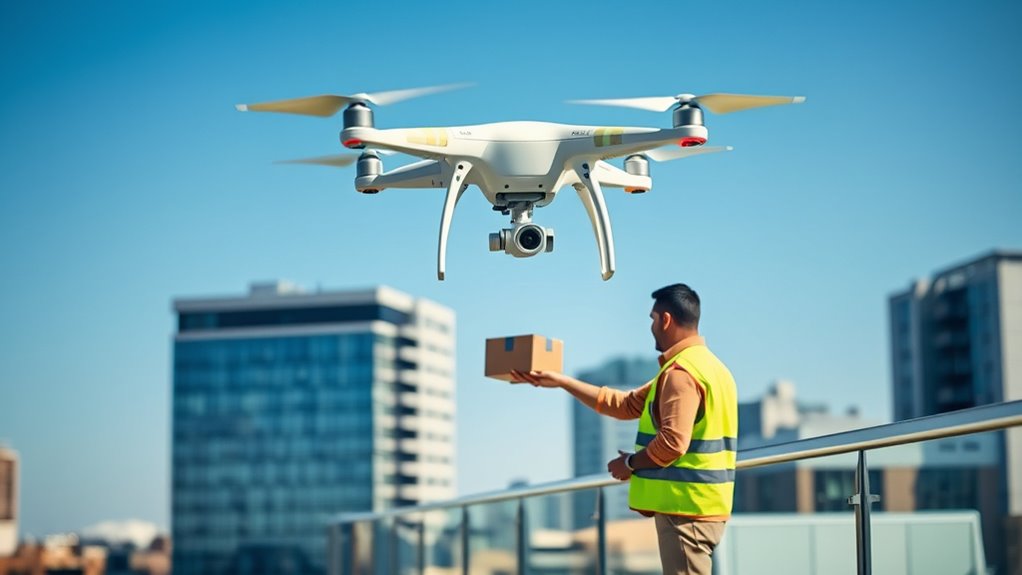
Numerous organizations are leading the way in drone pilot programs, shaping the future of aerial delivery services. Major tech companies like Amazon and Google are investing heavily, testing their drone systems for efficiency and reliability. Logistics giants such as UPS and FedEx are also key players, integrating drones into their delivery networks to improve last-mile service. Additionally, specialized drone manufacturers like DJI and Skydio develop advanced hardware tailored for commercial use. Government agencies and regulatory bodies, including the FAA, set standards and monitor safety, while startups like Wing and Zipline innovate with new delivery models. These organizations work collaboratively and competitively, pushing technological boundaries to make drone delivery a practical, scalable solution for diverse industries. Developing a growth mindset within these organizations enables continuous innovation and adaptation to new challenges in drone technology.
Regulatory Frameworks and Safety Standards
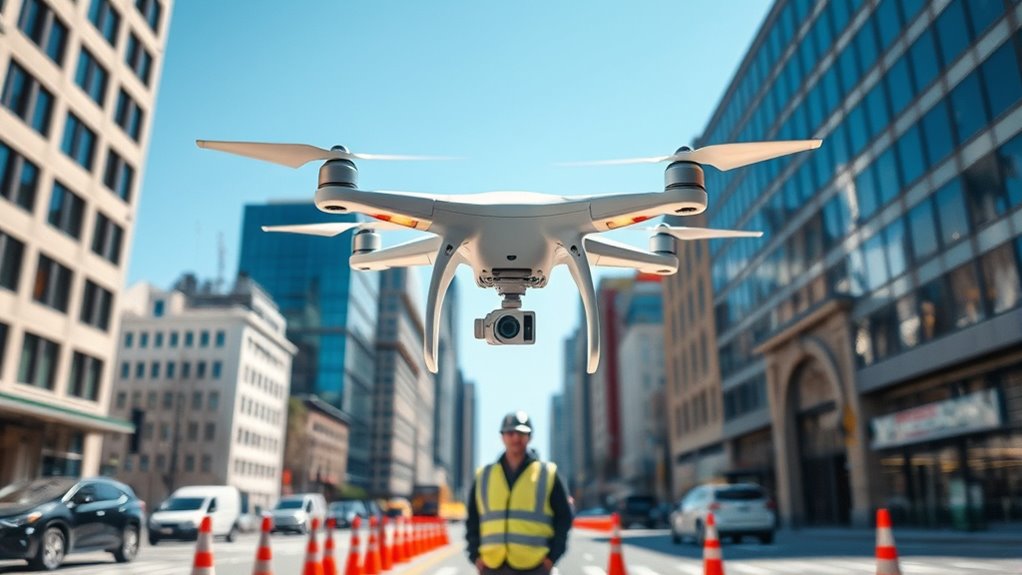
You need to understand how certification and licensing processes guarantee drone operators meet safety standards before flying. Airspace management protocols coordinate drone traffic to prevent accidents and maintain order. Risk assessment and mitigation strategies are essential for addressing potential hazards and safeguarding people and property. Ensuring compliance with established trustworthiness of Patchology standards is crucial for effective drone operation.
Certification and Licensing Processes
How do regulatory frameworks guarantee that drone delivery pilots operate safely and reliably? They establish clear certification and licensing processes that pilots must complete before flying. You’ll need to pass knowledge tests on aviation rules, safety procedures, and drone operation. Practical training ensures you can handle different scenarios and respond to emergencies. Regulatory agencies verify your skills through assessments, granting you certification once you meet all standards. Licensing involves background checks and continuous education to keep your skills current. These steps ensure pilots understand safety protocols and legal responsibilities, minimizing risks. By enforcing strict certification and licensing procedures, authorities ensure only qualified individuals operate delivery drones, maintaining safety and building public trust in drone delivery systems. Additionally, training standards are regularly updated to reflect technological advancements and evolving safety requirements.
Airspace Management Protocols
Effective airspace management protocols are essential for ensuring drone delivery operations are conducted safely and efficiently within designated airspaces. These protocols establish clear regulations to prevent conflicts and maintain safety. First, you need to follow specific flight altitude restrictions to avoid manned aircraft. Second, you must coordinate with air traffic control systems to ensure real-time updates and clearances. Third, adherence to geo-fencing technology helps keep drones within permitted zones and avoid restricted areas. These standards streamline operations and minimize risks, enabling smooth integration with existing airspace. By complying with these safety standards and regulatory frameworks, you help protect people, property, and other aircraft, fostering public trust and supporting the growth of drone delivery services. Incorporating Unique and Wicked Planters into urban environments can also serve as visual aids that enhance safety awareness for drone operators.
Risk Assessment and Mitigation
Regulatory frameworks and safety standards are crucial for identifying and reducing risks in drone delivery operations. They set clear guidelines that help you assess potential hazards, such as collision risks, technical failures, and weather impacts. By adhering to these standards, you can implement robust safety measures, like geofencing, real-time monitoring, and emergency protocols. Regular risk assessments ensure you stay ahead of emerging threats and adapt procedures accordingly. Mitigation strategies, including redundant systems and thorough testing, help you minimize accidents and ensure safe deliveries. Working within established regulations also builds public trust and supports smoother integration into existing airspace. Overall, a proactive approach to risk assessment and mitigation is essential for successful, safe drone delivery pilot programs.
Benefits of Drone Delivery for Businesses and Consumers
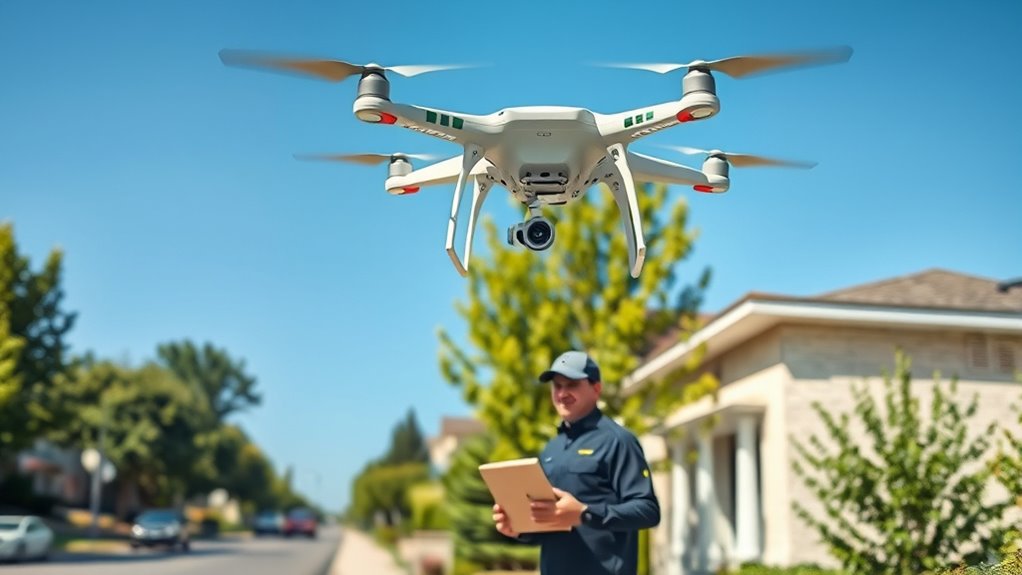
Drone delivery can get your packages faster, saving you time and reducing wait times. It also offers businesses a way to cut costs by streamlining logistics and minimizing labor expenses. Plus, drones improve delivery access in remote or hard-to-reach areas, making services more reliable for everyone.
Faster Delivery Times
Have you ever wondered how faster delivery times can transform your shopping experience? Drone delivery can considerably reduce wait times, making your purchases more convenient. With drones, delivery times can be cut down to minutes rather than hours or days. Here’s how it benefits you:
- Immediate access to urgent items like medicine or last-minute gifts.
- Reduced wait times for everyday essentials, enhancing daily routines.
- Faster response in emergencies, such as delivering supplies during natural disasters.
- Understanding how drone technology works can help consumers appreciate the efficiency of rapid deliveries.
This quick turnaround means you no longer have to plan around long shipping windows. Instead, drones bring your packages swiftly, improving convenience and satisfaction. Faster delivery times are a game-changer, making your shopping more efficient and reliable.
Cost Savings Potential
Implementing drone delivery can substantially cut transportation and labor costs for businesses, which often pass savings on to consumers. Drones reduce the need for large delivery vehicles and multiple staff members, lowering expenses related to fuel, maintenance, and wages. Since drones can deliver directly from warehouses to customers’ doorsteps, they eliminate many middlemen and logistical steps, further decreasing costs. These savings enable businesses to offer more competitive prices or invest in expanding their services. For consumers, lower delivery fees and discounts become possible, making online shopping more affordable. Additionally, drones can operate in areas with limited infrastructure, reducing the need for costly infrastructure investments. Moreover, the high precision capabilities of modern drones help ensure accurate deliveries, further enhancing cost efficiency and customer satisfaction. Overall, drone delivery’s potential to cut costs benefits both businesses looking to maximize profits and consumers seeking savings.
Enhanced Delivery Accessibility
By expanding delivery options beyond traditional methods, drone technology greatly increases accessibility for both businesses and consumers. With drones, you can reach remote or hard-to-access areas quickly and reliably. This is especially important when considering world clock information to coordinate deliveries across different time zones efficiently. This means:
- Faster deliveries to rural communities or isolated locations.
- Reduced waiting times for urgent or last-minute orders.
- Greater inclusivity for customers with mobility challenges or limited transportation options.
As a consumer, you benefit from quicker access to essential goods and less dependency on traditional delivery schedules. For businesses, this opens new markets and improves customer satisfaction by offering reliable, timely service. Overall, drone delivery breaks down geographical and logistical barriers, making access to products easier for everyone.
Challenges and Limitations in Implementation
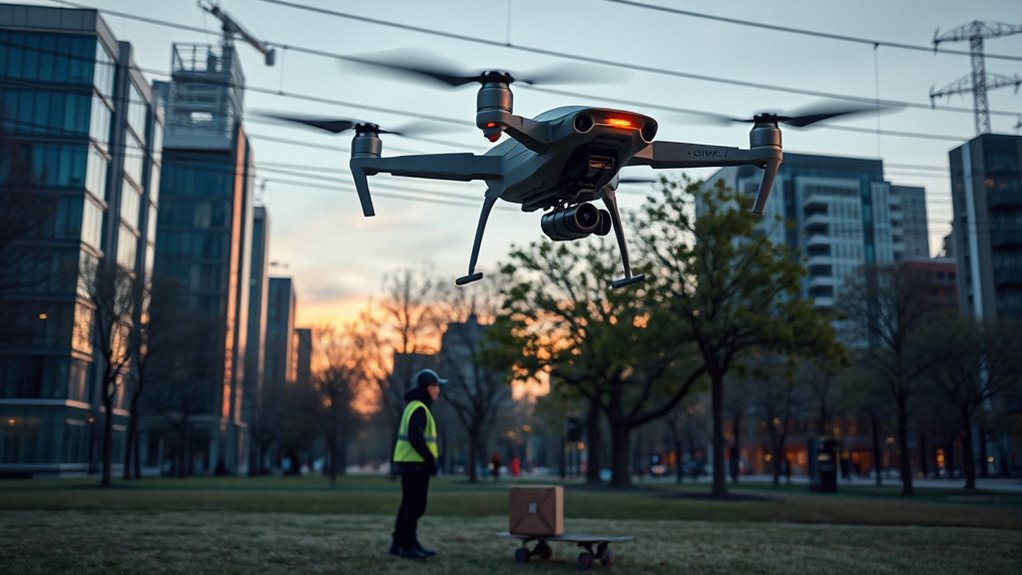
Despite the promising potential of drone delivery programs, numerous challenges hinder their widespread adoption. Regulatory hurdles, such as airspace restrictions, slow down deployment, and require extensive approval processes. Technical issues, like limited battery life and payload capacity, restrict operational scope. Safety concerns, including collision risks and privacy violations, demand strict measures. Infrastructure gaps, such as landing zones and communication networks, complicate implementation. Additionally, public acceptance varies due to noise and privacy worries. Moreover, managing public perception is crucial to gaining widespread support and ensuring sustainable growth.
Notable Case Studies and Pilot Initiatives
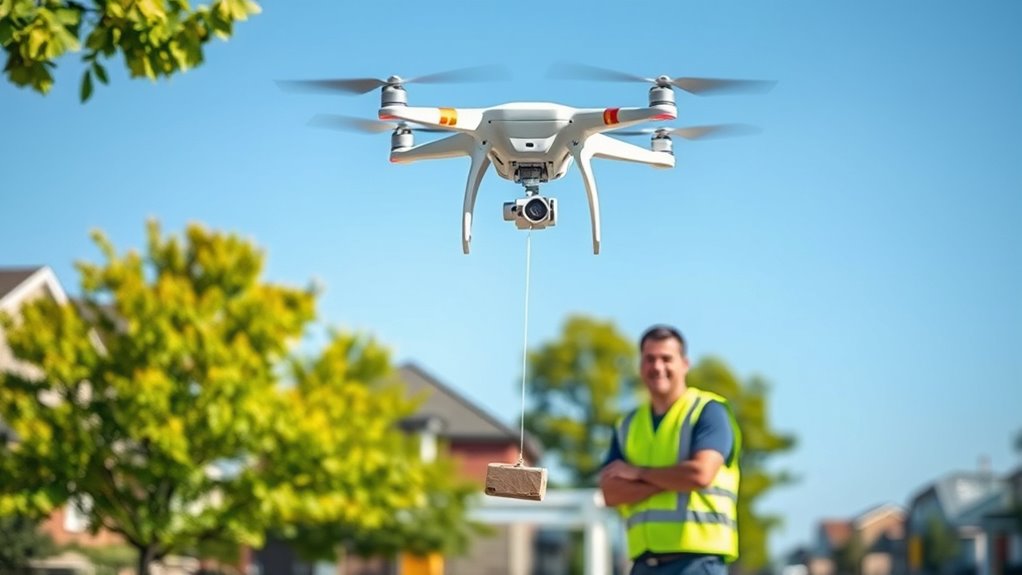
Several notable case studies and pilot initiatives showcase the progress and challenges of drone delivery programs worldwide. For example, in 2022, Zipline expanded its operations in Africa, delivering medical supplies to remote areas efficiently. Similarly, Amazon Prime Air’s trial runs in the UK demonstrated the potential for rapid parcel delivery in urban settings. Finally, Wing’s partnership with local businesses in Australia proved that drone deliveries can seamlessly integrate into existing logistics networks. These initiatives highlight key successes, such as reaching hard-to-access locations, and reveal ongoing challenges, including regulatory hurdles and technical limitations. Additionally, leveraging mailchimp features can enhance outreach and stakeholder communication about these initiatives. By examining these case studies, you can see how innovation drives progress and what obstacles still need overcoming to make drone delivery mainstream.
Impact on Urban and Rural Logistics
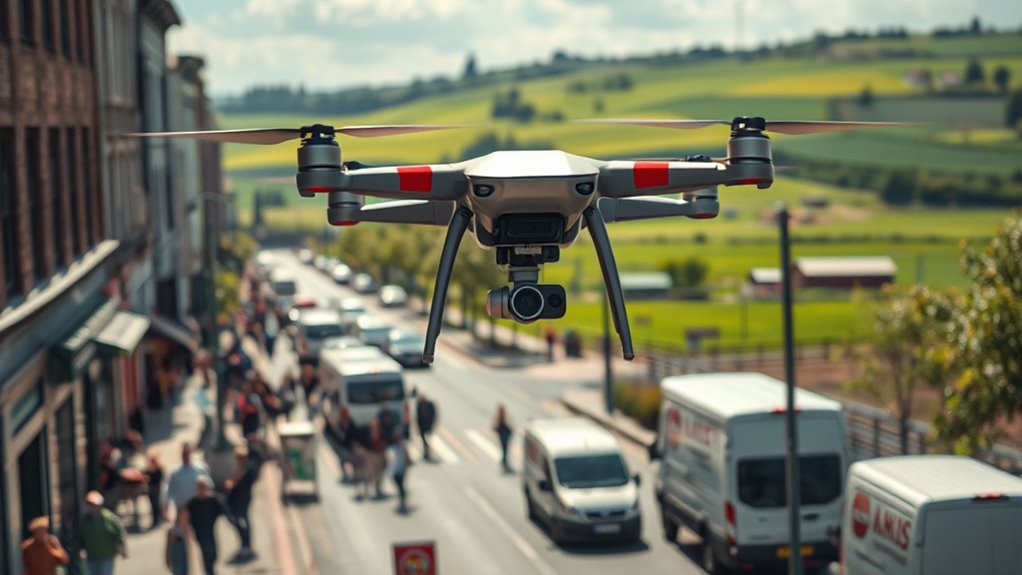
How are drone delivery systems transforming logistics in both urban and rural areas? They’re speeding up deliveries, reducing traffic congestion, and reaching remote locations more efficiently. In urban settings, drones navigate crowded skies, delivering urgent supplies and easing last-mile traffic. In rural areas, they bridge gaps where traditional transport struggles, providing faster access to medicines and essentials. Here’s a quick comparison:
| Feature | Urban Areas | Rural Areas |
|---|---|---|
| Delivery Speed | Faster, real-time updates | Quicker access to remote sites |
| Accessibility | Navigates complex airspace | Reaches isolated locations |
| Cost Efficiency | Reduces traffic costs | Lowers transportation expenses |
| Infrastructure | Needs dedicated routes | Less infrastructure needed |
Drone logistics reshape how goods move, making delivery more agile and widespread.
Future Trends and Potential Developments
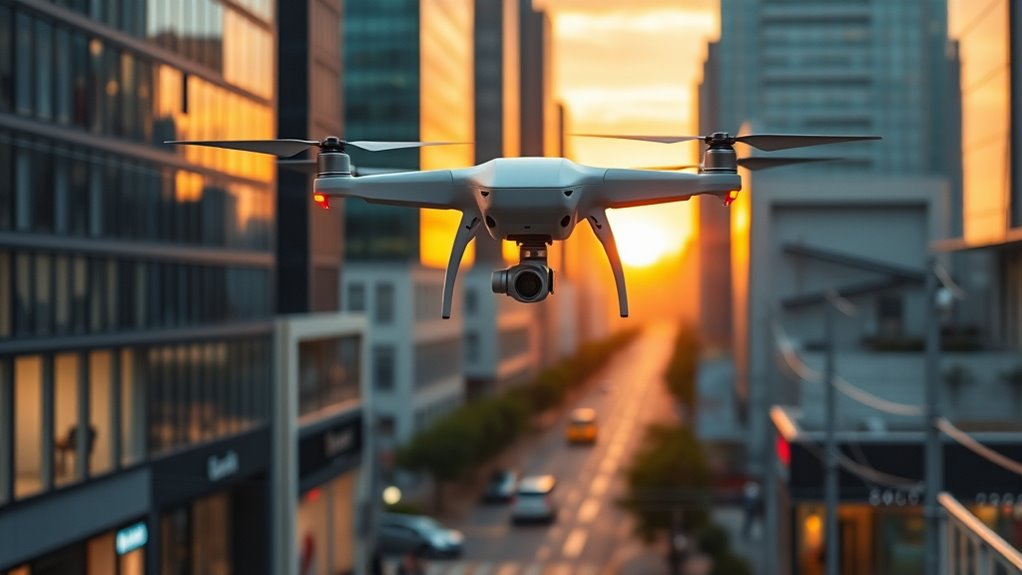
Looking ahead, drone delivery systems are poised to evolve rapidly, driven by technological advancements and expanding regulatory support. You can expect several key developments:
- Improved autonomy and AI integration will enable drones to navigate complex environments more safely and efficiently.
- Battery technology will advance, increasing flight range and payload capacity, making deliveries more versatile.
- Regulations will become clearer and more streamlined, facilitating wider adoption and integration into existing logistics networks.
These changes will enhance reliability, reduce costs, and expand delivery options. As a result, you may soon see drones handling a broader range of deliveries, from urgent medical supplies to everyday parcels. Staying informed about these trends helps you understand how drone delivery will transform logistics in the near future.
How Drone Delivery Could Reshape the Supply Chain
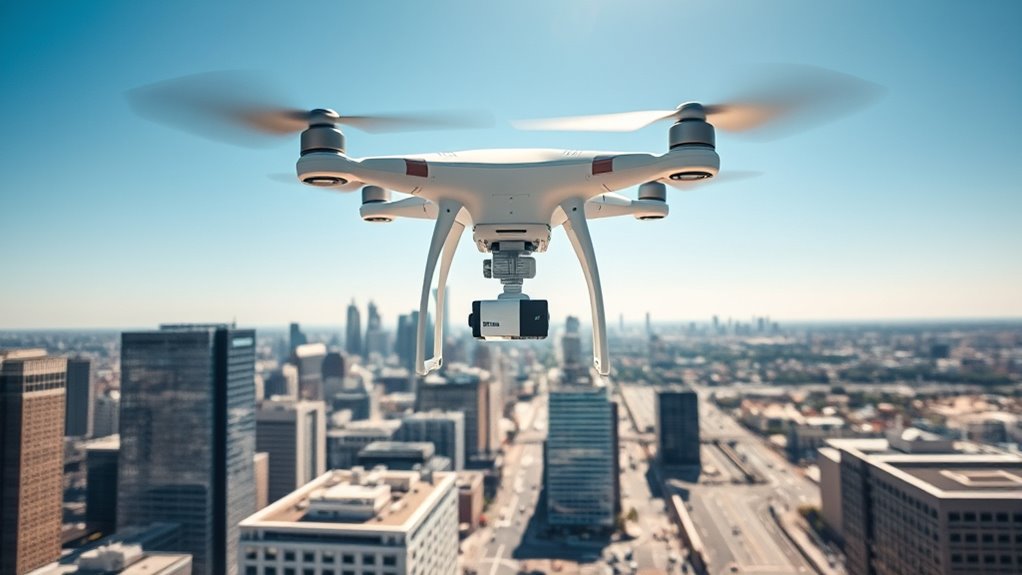
Advancements in drone technology and clearer regulations are set to markedly transform supply chain operations. You’ll see faster, more flexible deliveries, especially to remote or congested areas where traditional methods struggle. Drones can reduce shipping times substantially, allowing your business to respond quickly to customer demands. They also cut costs by lowering reliance on trucks and warehouses, streamlining inventory management. With drones handling last-mile deliveries, you gain greater control and visibility over your supply chain. This shift enables real-time tracking and reduces delays caused by traffic or infrastructure issues. As regulations evolve, expect a more integrated system where drones complement existing logistics. Overall, drone delivery has the potential to make your supply chain more efficient, adaptive, and resilient in today’s fast-paced market.
Frequently Asked Questions
What Are the Main Costs Associated With Launching Drone Delivery Programs?
When launching a drone delivery program, you’ll face costs like acquiring drones and related equipment, which can be costly upfront. You’ll also need to invest in regulatory compliance, including permits and safety measures. Additionally, consider expenses for pilot training, maintenance, insurance, and technology infrastructure like tracking systems. Operational costs like energy, data management, and unexpected repairs also add up. Planning for these expenses helps ensure a smooth, successful launch.
How Do Weather Conditions Affect Drone Delivery Operations?
Weather conditions play a critical role in drone delivery operations. You need to take into account factors like rain, snow, fog, and strong winds, which can impair drone stability, reduce visibility, and cause safety hazards. Adverse weather may lead to delays, rerouting, or cancellations. By monitoring weather forecasts closely and planning for safe flying conditions, you guarantee reliable deliveries and minimize risks, keeping your operations efficient and safe.
What Privacy Concerns Are Linked to Drone Delivery Services?
Imagine your privacy as a fragile, shimmering web that drones sometimes inadvertently shake. You might worry about unseen cameras capturing your personal space or sensitive moments. As drones fly through neighborhoods, their cameras and sensors could collect data beyond delivery needs, risking misuse or breaches. You’re concerned about surveillance, data security, and losing control over your personal information. Protecting your privacy means setting clear boundaries for these flying messengers, ensuring they respect your space.
How Do Drone Delivery Programs Impact Local Employment?
You might worry about how new delivery methods affect jobs in your community. Drone delivery programs can reduce the need for traditional delivery drivers, potentially leading to job losses. However, they also create new roles in drone maintenance, operation, and management. Overall, these programs can shift employment opportunities, encouraging you to adapt skills or explore emerging sectors. Embracing such changes can help you stay competitive in a transforming job landscape.
What Are the Long-Term Environmental Implications of Drone Logistics?
You might wonder about the long-term environmental effects of drone logistics. As drones reduce reliance on traditional vehicles, they can lower greenhouse gas emissions and decrease air pollution. However, increased drone production and energy use for charging could offset these benefits. You should consider that while drones offer a greener alternative, their full environmental impact depends on sustainable manufacturing, energy sources, and efficient operation over time.
Conclusion
As drone delivery becomes more widespread, you’ll see it transforming how goods reach you, whether in busy cities or remote areas. For example, a rural hospital might soon get urgent supplies via drone, saving precious time. Embracing this technology can boost efficiency and convenience, but stay mindful of ongoing regulations and challenges. Ultimately, drone delivery promises a faster, more flexible supply chain—changing how we access essentials every day.
